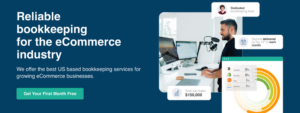
What are Amazon seller profits? What factors affect a seller’s profitability on the platform? Do the fees make it worth selling on the platform?
Amazon is a digital marketplace giant making billions of dollars annually. We would expect that a sizeable chunk of that filters down to the third party sellers on the marketplace. Let’s take a look and see if that’s actually true.
How Much Do Amazon Sellers Make?
What does an Amazon seller salary look like?
In a 2023 JungleScout report, a survey conducted with thousands of Amazon sellers revealed crucial data. When it came to monthly sales, most (17%) brought in $1000. Nearly half (45%) of all surveyed sellers made between $1000-$25,000 in monthly sales. 79% of these sellers are profitable and 67% of all sellers stated they became profitable in their first year.
We can see that Amazon is a platform that gives small businesses the opportunity and potential to earn money through their marketplace. But what contributes to making substantial Amazon seller profits?
Factors Influencing Amazon Seller Profitability in 2023

1. Product Selection and Niche Market Analysis
Finding your niche on Amazon is more likely to increase Amazon seller profits. Niche products are those that serve a specific type of customer base. These products target a narrowed-down audience in unique subcategories.
2. Pricing Strategy and Competitiveness
Pricing on Amazon is not a “set it and leave it” type of thing. Amazon is all about presenting the most competitive prices to shoppers. As such, sellers are always trying to present the most attractive option to please both the consumers and Amazon itself. This dynamic pricing model means repricing occurs quite frequently. You can expect products to be prone to more price fluctuations than brick-and-mortar stores. This can be advantageous to both sellers and shoppers. For sellers, they can maximize profits as they generate hype for in-demand products. For shoppers, they can enjoy more frequent discounts and periods of reduced prices for various products.
3. Amazon Fees and Expenses
A lot of people have asked the question, “How much profit does Amazon take from sellers?” Well, to get an idea of that number, you first need to consider several types of fees when selling on Amazon.
These fees include:
- Shipping Fees
- Referral Fees
- Variable Closing Fees
- Monthly Subscription Fees
- Listing Fees
- Refund Administration Fees
- FBA-related Fees
The primary ones you must consider are your monthly subscription, your applicable referral fees, and any FBA fees you need to pay.
Amazon has two plans:
- Individual – you pay $0.99 for every unit sold
- Professional – you pay $39.99 per month regardless of the number of units sold
Referral fees are charged per item sold. These are calculated as a percentage based on which product category your items fall under.
More on FBA fees later.
4. Advertising and Marketing Efforts

Amazon Ads gives shoppers a variety of tools and methods to launch paid advertising campaigns on their platform.
Amazon Ads offers the following:
- Sponsored Products
- Sponsored Brands
- Sponsored Display
- Audio Ads
- Video Ads
- Amazon DSP
- Custom Advertising
5. Inventory Management and Fulfillment Costs
Amazon’s fulfillment option, Fulfillment by Amazon (FBA), includes certain fees. These fees are based on the product category (apparel and non-apparel) and product weight and dimension. These per-unit fees cover picking and packing, shipping and handling, customer service, and product returns.
They charge monthly inventory storage fees based on product tiers. There is also a surcharge on inventory that remains in their warehouses for more than a year. They either charge per unit or cubic foot depending on which is greater.
You can learn more about product sizing tiers and other FBA fees on Seller Central.
6. Customer Service and Product Reviews
According to Power Reviews, 74% of consumers use Reviews and Ratings to learn about products. Of these, 93% say that Reviews and Ratings impact their purchasing decisions. Also, Reviews and Ratings are a ranking factor on Amazon results pages. In other words, Amazon seller profits come partially from the feedback they receive from their customers.
Customer service is all about making sure the experience of purchasing the product is the best it can be. What if you were to set up shop at the top of a steep hill with thousands of steps between you and your customer? Sure, if you have a stellar product, some people might be willing to make the trek. However, you would still be significantly restricting your customer base. Most people are likely going to find a more convenient way of getting their hands on the product. Usually, this means going to a competitor. And you must know that many people will choose convenience even if the product is of lower quality.
Going the extra mile for customers also applies in the area of refunds. If you are gracious with refunds, it shows your value is in the customer, not just their money. This builds loyalty, and that is priceless over the long term.
7. Marketplace Trends and Seasonality
Sellers who are sensitive to what is popular and are aware when certain items sell at higher rates typically perform better on the platform.
Seasonality in this case refers to predictable patterns of product sales volume. This affects Amazon seller profits because identifying when products sell better is the first step to creating better marketing around those seasons. Seasonality must also be considered when calculating year-over-year growth.
Estimating Profit Margins for Amazon Sellers in 2023

1. Gross Profit Margin Calculation
Gross profit is the amount of money you are left with after deducting CoGS or Cost of Goods Sold. The value of your Gross Profit Margin is represented as the percentage value.
The formula for Gross Profit Margin is [(Revenue – Cost Of Goods Sold) / Revenue] x 100
2. Net Profit Margin Calculation
Net profit is the amount of money you are left with after calculating gross profit and deducting other business expenses. The value of your Net profit margin is represented as a percentage value. If you know your net income (Gross Revenue – Expenses) it’s easy to calculate your net Amazon seller profit margin.
The formula for Net Profit Margin = (Net Income / Sales) x 100
3. Understanding FBA and FBM Models
FBA or Fulfilled by Amazon is a fulfillment model where Amazon takes care of inventory storage, packaging, shipping, and returns for you. These fees depend on the size of your packages. Standard size usually falls around the $5-$8 range and oversize can be anywhere between $8 and $140. You can use an FBA Revenue calculator to help you determine your Amazon FBA profit margin as well as your Amazon seller profits overall.
In FBM or Fulfilled by Merchant, the seller is responsible for storage, packing, shipping, and handling returns. These fees vary depending on the infrastructure you have in place to handle the aforementioned processes.
4. Evaluating Return on Investment (ROI)
Return on Investment (ROI) is a performance metric that measures the value or profitability of an investment. This is often expressed in a percentage value. The higher the value the better. The formula for ROI is [(Profit – Cost of Investment) / Cost of Investment] x 100
5. Identifying Cost-saving Opportunities
There’s always a place where you can be more efficient with the use of resources. Mostly, this involves either time or money. Better budgeting begins with finding areas where you can better manage your invaluable resources like these.
This can be done through
- Reporting and financial analysis
- Sales analysis
- Tracking KPIs and key eCommerce metrics
- Bookkeeping specifically expense tracking and inventory management
Strategies to Maximize Profitability on Amazon in 2023

1. Conducting Regular Financial Analysis
The more you analyze, the more likely it is that you can track budgets, sales, key metrics, etc., and make better business decisions. As long as you have enough significant data to work off, of course. You don’t want to jump the gun based on insufficient information. That being said, you should look at your financial statements at least once a month. Check these together with your bookkeeping to make sure that everything lines up.
2. Optimizing Product Listings and Descriptions
A big factor that influences how you rank on Amazon results pages is how well your listings are optimized to their A9 algorithm. This algorithm powers the Amazon product search engine.
The factors that influence product ranking include:
- Image Quality
- Keywords
- Conversion Rate
- Clickthrough Rate
- Stock Availability
- Impressions
- Price
- Reviews and Ratings
3. Monitoring and Adjusting Pricing Strategies
Analyze your competitors. Make sure that you are constantly taking notes from other sellers in your lane and finding ways you can one-up your deals. You can implement bundling and packaging deals, do sales, offer discounts, and capitalize on seasonality.
4. Implementing Effective Advertising Campaigns
Your Amazon PPC strategy should involve keyword research, bidding, and structuring your campaigns to how your products are performing.
5. Expanding Product Offerings and Diversifying
When it comes to your product catalog, broadening your spread of products is essential for better profit margins. You can take market trends into account and add popular items to your store. You also need to take product cohesion into account. Look at other listings of the product you sell, specifically at competitor listings. Then, scroll down and view the “Products related to this item” and “Frequently bought together” sections of these product pages. From there you can start adding the items that make sense for you. You may find a gap that your competitors haven’t seen yet and capitalize on it.
6. Enhancing Customer Satisfaction and Reviews
Customer satisfaction involves tracking and improving certain metrics such as customer lifetime value and customer retention rates. You can improve your customer service by providing multiple methods of contact and improving response times. Keep your customers informed as much as you can during the purchase, fulfillment, and even post-purchase stages.
7. Staying Updated with Amazon Policies and Changes
The Ecommerce space as a whole is very dynamic and is always evolving. This means that if you are not willing to keep up, you could get left behind. Worse, you could miss a policy change and incur a violation. Keep yourself up to date on the latest Amazon news that could affect your operations. Frequent sites like AMZ Scout and Jungle Scout, and forums in Seller Central.
Frequently Asked Questions
How do I calculate my profit margin as an Amazon seller?
Gross Profit Margin = [(Revenue – Cost Of Goods Sold) / Revenue] x 100
Net Profit Margin = (Net Income / Sales) x 100
What are the fees associated with selling on Amazon?
The main ones are:
- Shipping Fees
- Referral Fees
- Variable Closing Fees
- Monthly Subscription Fees
- Listing Fees
- Refund Administration Fees
- FBA-related Fees
Is it better to use Fulfillment by Amazon (FBA) or Fulfillment by Merchant (FBM)?
If you have a method of fulfillment that is more cost and time efficient in terms of inventory storage and shipping, you can go the FBM route. However, if you believe that Amazon FBA profits are worth the fees, then go for that.
How important are customer service and reviews for profitability on Amazon?
A majority of people use reviews as social proof of how good a product is. Reviews mean less risk to themselves and more trust in the product.
Customer service is important because it can determine how willing a customer is willing to buy from you again. You can offer an amazing product, but a bad purchasing experience could bring the whole thing down.
What Is EcomBalance?

EcomBalance is a monthly bookkeeping service specialized for eCommerce companies selling on Amazon, Shopify, Ebay, Etsy, WooCommerce, & other eCommerce channels.
We take monthly bookkeeping off your plate and deliver you your financial statements by the 15th or 20th of each month.
You’ll have your Profit and Loss Statement, Balance Sheet, and Cash Flow Statement ready for analysis each month so you and your business partners can make better business decisions.
Interested in learning more? Schedule a call with our CEO, Nathan Hirsch.
And here’s some free resources:
- Monthly Finance Meeting Agenda
- 9 Steps to Master Your Ecommerce Bookkeeping Checklist
- The Ultimate Guide on Finding an Ecommerce Virtual Bookkeeping Service
- What Is a Profit and Loss Statement?
- How to Read & Interpret a Cash Flow Statement
- How to Read a Balance Sheet & Truly Understand It
Conclusion
Now you have a better understanding of the fees that are associated with selling on Amazon You also know what profit margins you can expect, and how to increase Amazon seller profits. What’s next? Should you get an Amazon account set up? Do you need to conduct market research? Maybe you need to learn more about the A9 algorithm or PPC strategy. All those are great steps to begin selling on the platform. Maybe you’d also like to know about more ways to increase your Ecommerce profits. If so, keep browsing to learn more!








